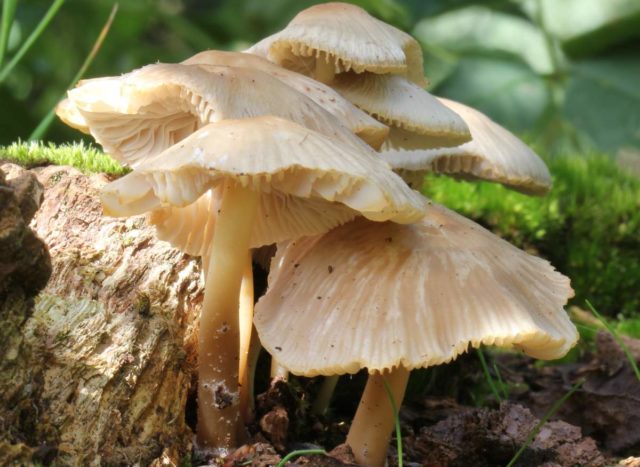Content
Mycena capacidae is an inedible representative of the Mycena family. It grows in small families in mixed forests and bears fruit throughout the warm period. To avoid confusing the species with edible specimens, you need to carefully familiarize yourself with the external characteristics and view photos and videos.
What do cap-shaped mycenae look like?
Getting to know a forest dweller should begin with a description of the fruiting body. The hat of young specimens is bell-shaped; as they grow older, it straightens a little, and in full maturity it takes on the shape of a wide bell with a small mound in the center. The radial-ribbed surface, up to 6 cm in diameter, is colored from gray-brown to light pink. The whitish pulp is fragile and thin, with a mealy taste and smell.With mechanical damage, the color does not change.
The lower layer is formed by narrow, loose plates of off-white color. Reproduction occurs by microscopic smooth spores, which are located in a whitish powder. Cylindrical leg of regular shape, 10 cm high. The structure is hollow, brittle, hard. The surface is colored to match the cap, but closer to the base it becomes light brown with clearly visible characteristic hairs.

Inedible, but not poisonous
Where do Mycena capacidae grow?
Mycena bell-shaped is widespread throughout the world. Prefers to grow next to rotting coniferous and deciduous trees. They can also be seen on stumps, woody substrate, and dead wood. It grows in groups and bears fruit from June to November.
Is it possible to eat cap-shaped mycenae?
This representative of the mushroom kingdom is inedible, but not poisonous. Due to the lack of nutritional value, the mushroom is not used in cooking. But if mycena capulaceae somehow gets on the table, then it will not cause food poisoning.
All members of this genus grow on dead wood and come in a variety of shapes, sizes and colors. There are many types of Mycena, but all of them mostly belong to bell-shaped and oblique Mycena. In one colony there are both young and fully mature representatives. As they grow older, mushrooms change shape and color, which confuses mushroom pickers. The cap-shaped mycena differs from its fellows in the color of the plates and the presence of transverse veins between them.
In order not to harm your body and not gain toxic specimens, you need to carefully study the external data. Mycena capulidae has similar counterparts, such as:
- Alkaline - an inedible representative with a hemispherical, then outstretched cap. The thin surface is painted in creamy chocolate or fawn tones. The stem is long, hollow, much lighter than the cap, and spider fibers are visible at the base. Fruits all summer, grows in large families on spruce cones and coniferous substrate.
Grows on dead wood
- Threadlegs - an inedible specimen with a conical light or dark brown cap. In dry weather, a silvery coating appears on the surface. The smooth leg is thin and long, painted snow-white on top, and closer to the base it becomes coffee-colored with pronounced whitish fibers. The gray pulp is fragile, tasteless and odorless. In fully ripened specimens, the pulp emits a strong iodine aroma. Grows on deciduous and coniferous substrates, prefers fertile soil. Found in single specimens and small groups. Fruits from May to July.
Due to the lack of taste and smell, the mushroom is not eaten
- Dairy – this species, despite the lack of taste and smell, is eaten. You can recognize it by its small, bell-shaped cap, thin stem, and gray-coffee color. Grows in mixed forests on rotten wood. Fruits all summer. In cooking they are used in fried, stewed and canned form. Since the genus has poisonous counterparts, the collection of these representatives of the mushroom kingdom should be carried out by an experienced mushroom picker.
Beautiful, petite look
- Clean – hallucinogenic, poisonous forest dweller. The fruit body is small, the surface is mucous, light chocolate color. The cylindrical stem is thin, fragile, 10 cm long. Fruits on dead wood, from May to July.Since the species can be harmful to health, during mushroom hunting you need to be extremely careful and be able to recognize it.
Dangerous mushroom – causes poisoning and visual hallucination
Conclusion
Mycena capulata is an inedible, but not poisonous representative of the mushroom kingdom. It grows on dead wood and bears fruit all summer until the first frost. Experienced mushroom pickers recommend, in order not to harm yourself and your loved ones, and also to replenish the population, not to pick, but to pass by an unfamiliar specimen.












